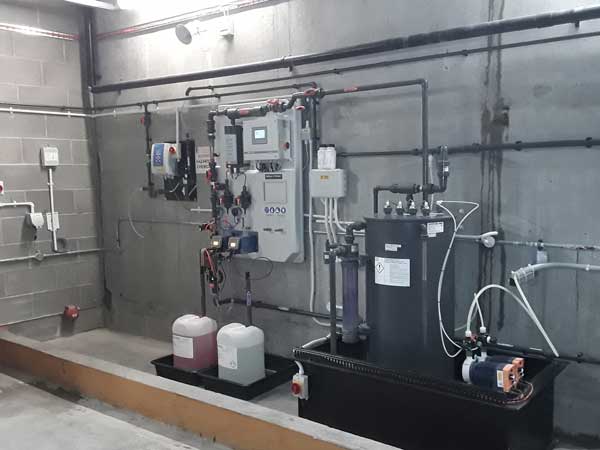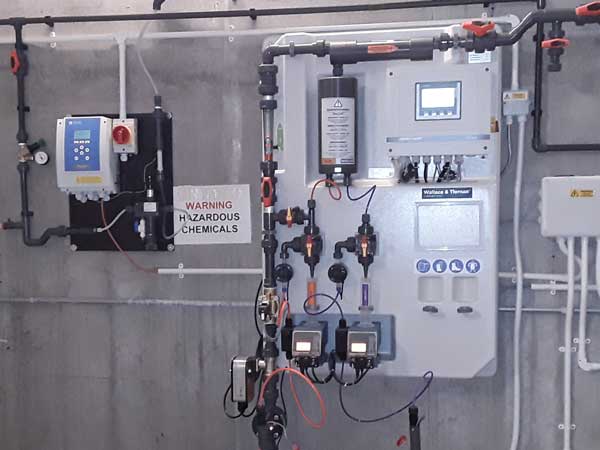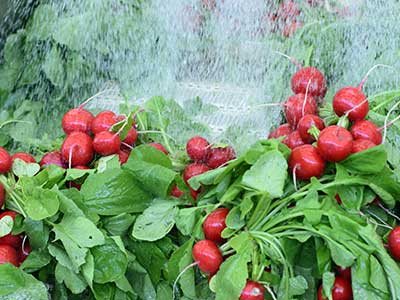Case Study: Stadium water supplyThe dosing of water supplies with chlorine dioxide is a very common and effective method of preventing Legionella within buildings and facilities. Prodose has recently specified and installed a chlorine dioxide generation system in a...

Major UK Stadium Case Study
Major UK Stadium Case Study
Case Study: Stadium water supply
The dosing of water supplies with chlorine dioxide is a very common and effective method of preventing Legionella within buildings and facilities.
Prodose has recently specified and installed a chlorine dioxide generation system in a large, well-known sports stadium in the UK. This will help the venue to ensure a safe supply of water across all of the site facilities at all times.
The building management team got in touch with us because they were routinely finding low levels of chlorine dioxide in toilet facilities throughout the site.
We looked at the frequency and volume of water use within the stadium. As is usually the case with such venues, demand for water was extremely high during events but also very low at other times. This meant that, during long periods when water within the system was either not flowing or hardly at all, the levels of residual chlorine dioxide dropped down to unacceptably low levels.
We recommended the installation of a larger chlorine dioxide generator and an emissions-proof water storage tank. The large capacity of the generator would be able to keep up with the spikes in water demand during events, for example at half time when many audience members all visit the toilet facilities at the same time.
The water storage tank needs to be emissions-proof in order to prevent chlorine dioxide fumes from entering the plant room. The tanks are very large in order to cope with peak demands. This does however mean that water can be standing static in them at other times, so it is important to be able to monitor this water for chlorine dioxide level to ensure residual levels do not drop too low.
To enable this, we installed a tank recirculating line with a chlorine dioxide residual analyser. This constantly monitors the levels of chlorine dioxide and tops them up when they drop below a predetermined level.
The system has now been up and running for a period of time and the client has been very pleased to now be recording consistent levels of chlorine dioxide throughout the site. This has remained steady at all times, regardless of how long it has been since a large audience attendance.

Further Case Studies
Major UK Stadium Case Study
Bagged Salad Producer
A supplier of bagged salads approached us in 2015 to see if we could help them streamline their disinfection process and save costs. The company produces various products for a number of clients. This includes privately labelled items for some well-known supermarkets....
Recent Articles
Why is Electrochlorination the Best Choice for Swimming Pool Disinfection?
Why is Electrochlorination the best choice for swimming pool disinfection?All swimming pools should be regularly and thoroughly disinfected. This eliminates harmful pathogens that cause sickness in swimmers and prevents the growth of other biological organisms, such...
What is the Electrochlorination Process?
What is the Electrochlorination process?Electrochlorination is the process of applying an electrical current to salt water to produce dilute sodium hypochlorite (bleach) and hydrogen gas. The resultant sodium hypochlorite solution contains between 0.7%-1% chlorine....
Chlorine Dioxide and Legionella Control
Chlorine Dioxide and Legionella ControlLegionella is a bacterium found in soil and water. When it occurs outdoors, it usually does so in low concentrations and doesn’t cause problems. However, when it grows inside artificial water systems, such as hot tubs, hot water...
Chlorine Dioxide and Water Treatment for Plant Nurseries
Chlorine Dioxide and Water Treatment for Plant NurseriesHorticultural facilities, such as plant nurseries, face many of the same water sanitation issues as their agricultural counterparts. These issues include keeping ornamental and food plants healthy, maintaining...
Keeping it clean: the use of Chlorine Dioxide in the Food and Beverage Sector
Keeping It Clean: the use of Chlorine Dioxide in the Food and Beverage SectorChlorine dioxide is rising in prominence as the best water treatment additive for the food and drinks industry. It’s powerful and economical, and may be a more practical solution for...
Chlorine Dioxide: the practical choice for water treatment in the UK
Find out about Chlorine Dioxide and why it makes such an effective water treatment for the food industry and other industrial practices.
Is the chlorine dioxide dosing system within your facility providing you with sufficient residual levels to be sure your employees or visitors are protected at all times? If you have any doubts about the effectiveness of your system, or would like to find a smarter way to control your chlorine dioxide dosing, please get in touch with us. We can cover every aspect, from initial consultation to final commissioning of a new system.


